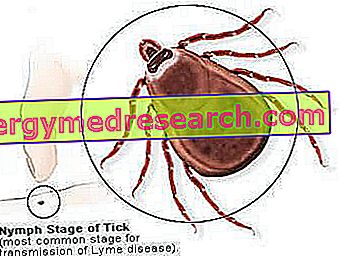Generality Rheumatism in the blood identifies a disease characterized by an acute inflammation that mainly involves the joints and the heart . Also known as rheumatic fever , rheumatism in the blood can represent the late complication of an infection by group A streptococcus , a pathogen that commonly causes inflammation of the throat (pharyngitis) and tonsils (tonsillitis)
Category infectious diseases
Generality Varicella incubation time is defined as the period between the contraction of the infection and the onset of symptoms. Chickenpox is a highly contagious infectious viral disease that causes a characteristic rash ( exanthema ). The infection that leads to the disease in question develops inside the patient slowly and initially asymptomatically
Scroll down the page to read the summary table on leptospirosis Leptospirosis General term including a series of systemic infectious zoonoses with acute course, caused by bacteria belonging to the genus Leptospira Leptospirosis: synonyms Autumn fever Seven-day fever Swamp fever Mud fever Dog cutter fever Icterememorrhagic fever Icteric leptospirosis Pork fever Leptospirosis: first descriptions Late eighteenth century: first description of leptospirosis by a well-known surgeon, but diagnosed as a plague 1870: first correct diagnosis 1917: identification of the responsible beat Leptospirosis: epi
Leptospirosis As analyzed in the previous article, leptospirosis represents a group of infectious syndromes caused by spirochetes of the genus Leptospira. However, it should be pointed out that not all species of these microorganisms are pathogenic to humans: over 200 different serotypes are currently recognized - known with the name serovar - and the serovar icterohaemorrhagiae is certainly the most dangerous and virulent
Definition of leptospirosis "Leptospirosis" is a general term comprising a series of systemic infectious zoonoses, with an acute course, caused by bacteria belonging to the genus Leptospira . Leptospirosis is known by many synonyms, and among the best known are: autumn fever (akiyami, in the Japanese language), seven-day fever (nanukayami, in Japanese), swine fever or - in the case of icteric leptospirosis - swamp fever, mud fever, dog-cutter fever or jaundice hemorrhage
Key points Lymphangitis (or blood poisoning) is an inflammation of the lymphatic vessels with a predominantly bacterial etiology. Lymphangitis: causes Most of the diagnosed lymphangitis is triggered by streptococci. Also other pathogens can trigger lymphangitis: staphylococci, Spirillum minus , Brugia malayi , Pasteurella multocida and Wuchereria bancrofti
Generality Yeasts , from those with pathogenic to harmless properties, are eukaryotic microorganisms consisting of a single cell and belonging to the kingdom of fungi. Heterotrophic living beings, yeasts reproduce by binary splitting or budding, they prefer damp environments and do not grow by means of so-called hyphae (which instead are typical of all other species of mushrooms)
Scroll down the page to read the summary table on Lyme disease Lyme disease Anthropozoonosis of bacterial origin transmitted by ticks which mainly affects the skin; often the internal organs, the joints and the nervous system are also affected Lyme disease: incidence The most frequent human disease transmitted by ticks 1985: 14, 000 patients diagnosed with this disease were diagnosed Italy: Lyme disease endemic in the North (in Liguria, Trentino and the Carso) Globally: Lyme disease has endemic outbreaks around the world, ranging from Japan to Canada, from Australia to Europe Etymology of the t
Key points Sleeping sickness (or African trypanosomiasis) is a parasitic infection transmitted to humans by the bite of an infected tsetse fly. Causes Sleeping sickness is caused by a flagellated protozoan parasite, Trypanosoma brucei : Trypanosoma brucei rhodesiense : etiological agent of East African trypanosomiasis (subacute sleep disease, which presents a violent and brief course) Tripanosoma brucei gambiens : causal agent of the Gambian African sleeping sickness (chronic trypanosomiasis) Symptoms Hemolymphatic phase of sleeping sickness: joint pain, intermittent fever, swollen lymph nodes
What is Lyme disease? Lyme disease is a pathology of bacterial origin that mainly affects the skin, but often internal organs, joints and the nervous system are also affected. Lyme disease belongs to the anthropozoonosis group, that is to say that group of diseases that can be transmitted naturally from vertebrate animals to humans
Introduction Although they usually populate the respiratory mucosa without causing damage, pneumococci, finding the optimal conditions for them, can replicate themselves disproportionately, transforming themselves from commensal microorganisms to terrible opportunistic pathogens, capable of triggering diseases of varying size










